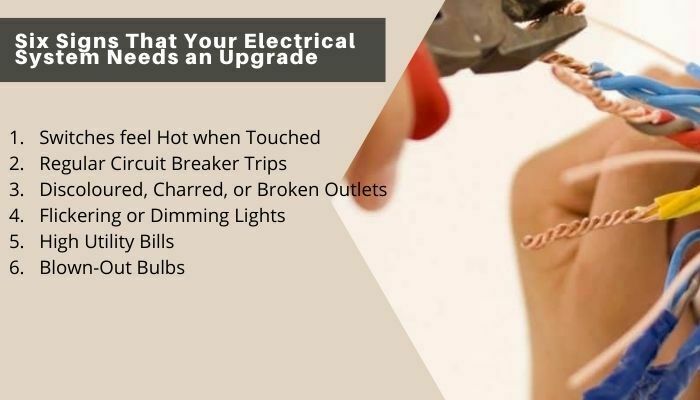Six Signs That Your Electrical System Needs an Upgrade
You knew you'd have to take extra care of your older house when you bought it. The faucet was leaking, the carpet was stained, and the yard had become overrun with weeds.
However, despite the apparent issues, you never had any concerns regarding the electrical system. All of the switches worked well, and all of the outlets quickly charged your phones and computers. You didn't notice any power outages, and your appliances continued to function correctly even when they were all turned on simultaneously.
On the other hand, your electrical system may be at a more significant risk than you realize. In fact, if you see any of the warning indications below, your plan might be on the verge of failing.
Below we have enlisted six signs that suggest your electrical systems needs an upgrade. They are:
- Switches feel Hot when Touched
- Regular Circuit Breaker Trips
- Discoloured, Charred, or Broken Outlets
- Flickering or Dimming Lights
- High Utility Bills
- Blown-Out Bulbs
Switches feel Hot when Touched
Your light switches may feel hot when you turn the lights off again, even though they turn the lights on without any effort. A number of factors might cause this heat, but the most common is electrical overload.
When power passes through your switch, it produces a small quantity of heat. Switches that are improperly placed or malfunctioning use more electricity than they can manage, resulting in excessive heat. The heat puts extra strain on the electrical components, and when the wiring deteriorates, you might end up with a fire.
Regular Circuit Breaker Trips
Your electrical circuit is protected against overloads by circuit breakers. When the breaker detects too much energy flowing through the wires, it cuts the power off or "trips" the circuit.
The fact that your circuit breaker trips now and again indicates that it has done its duty. On the other hand, breaker tripping on a regular basis signal poor wiring and electrical panel concerns. Furthermore, frequent journeys may cause your modern appliances and gadgets to draw more volts than your present system can manage, necessitating a system update to satisfy your electrical needs.
Discoloured, Charred, or Broken Outlets
Dirt, dust, grease, and filth may all cause your outlets to yellow and discolour. You can usually wipe away the junk to keep your outlet looking brand new.
However, if your outlet has charring or soot on it, a small fire has already begun inside the walls. Sparks are caused by faulty wiring, which eventually results in fire. The dark staining on the outlet is caused by the flames emitting soot and smoke.
Flickering or Dimming Lights
Depending on where they are in your home and how often they flicker, your lights might flicker for a variety of reasons:
- In one room, they flicker. A defective lightbulb causes flickering lights in this scenario. The flickering should stop once you replace the bulb and screw it in securely.
- When the furnace is turned on, they flash. When heating and cooling equipment are turned on, they consume a lot of electricity, sometimes more than 100 amps. The average household has a 200-amp electrical service, which causes the other lights to flicker due to the increased power use. To reduce flickering, make sure your outdoor unit is wired to the maximum ampacity and that the connections are secure.
- They flare throughout the house. Some service wires in your electrical panel may have come loose if you don't have any large appliances operating, and the lights flicker throughout your home regardless.
- They whirl throughout the neighbourhood. Do your neighbours complain about the same thing? Damaged power lines and electrical infrastructure may cause power outages in your area. To isolate and correct the problem, the power provider may need to turn off the electricity for a while.
Whatever the cause, you should always be cautious near flickering lights and consult an electrician if the problem persists.
High Utility Bills
Your power bill should, in general, reflect your way of living. Your monthly utilities should be minimal if you use lights for a few minutes before going to bed and have few, if any, significant appliances. Your expenses should be more effective if you regularly charge phones, tablets, computers, and gaming consoles while running your dishwasher, dryer, and air conditioner.
If you relocate to an older house and see a substantial increase in your utility cost, your home may have defective wiring. Inadequate wiring and corroded parts use more energy to power your appliances, increasing your kWh (kilowatt-hour) use.
Blown-Out Bulbs
The average incandescent lightbulb lasts between 1,000 and 2,000 hours until it burns out, depending on the brand. As a result, to provide uniform illumination, you'll need to change your lamp and ceiling lightbulbs regularly.
However, if you discover that your bulbs aren't lasting as long as they should, you may need to consider repairs. Faulty wiring might allow an excessive amount of power to flow into the bulb, causing it to deteriorate prematurely. Heat could build up inside the bulbs if your covered or recessed light features were appropriately fitted, resulting in a reduced life expectancy.
Conclusion
As you can see, several of the issues listed above increase the risk of fire and other harm to your property. So, if you observe any of these signs in your electricl system, contact an electrician to discuss rewiring or improving your present system.


 0405 900 741
0405 900 741





 Call Now
Call Now